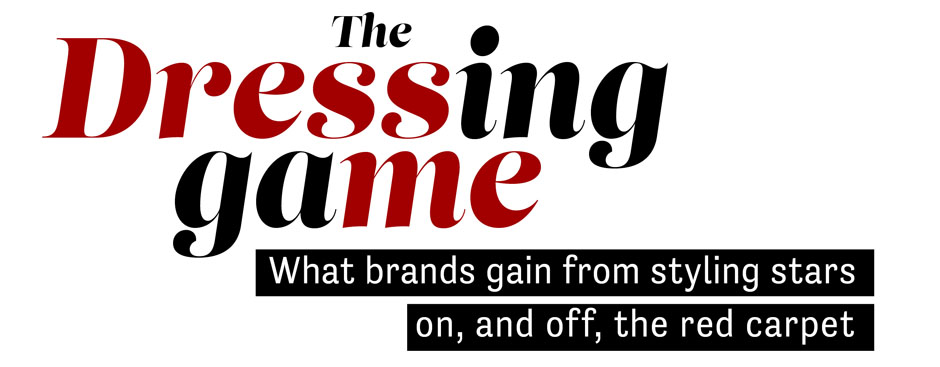


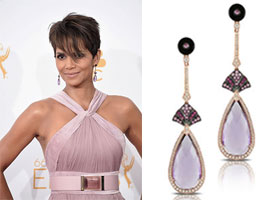
Halle Berry wore these amethyst and mother-of-pearl earrings by Doves by Doron Paloma to the Primetime Emmys in August. Landing on the ears of this A-list actress was a major placement for a smaller brand.
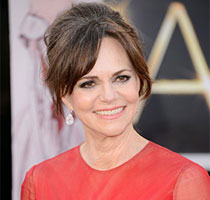
Sally Field wearing Martin Katz diamond drop earrings to the 85th annual Academy Awards in February 2013, the year she was nominated for a best supporting actress Oscar for playing Mary Todd Lincoln in Lincoln, opposite Daniel Day Lewis. Photo courtesy of Martin Katz
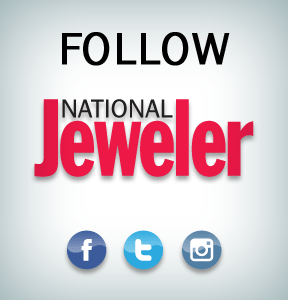
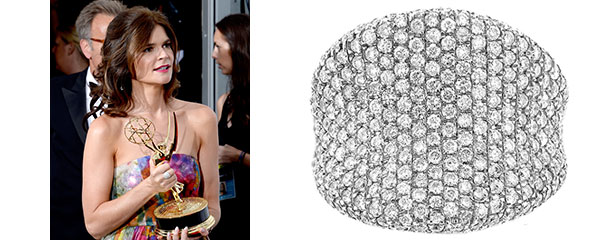
An up-close look at the diamond pave cocktail ring from Kallati that Breaking Bad’s Betsy Brandt wore to the Primetime Emmy Awards this year. The ring totals 2.25 carats of diamonds set in 14-karat white gold.
Ring photo courtesy of Kallati
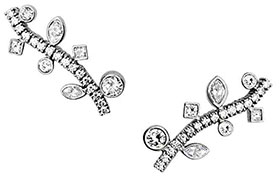
The 14-karat white gold diamond ear climbers Susan Eisen designed for Lauren Parsekian, wife of Breaking Bad star Aaron Paul.
By Michelle Graff
Shortly after the holiday season ends and the last of the tinsel is packed away, a new awards season will spring to life. Photographers will clamor and jostle along the fringes of Hollywood’s red carpets, angling for pictures of the year’s top stars in their awards-show best.
Amid the din will sound a familiar refrain: Who are you wearing? Those celebrities who accurately and completely can recall just exactly what it is they’ve got on will give those brands a recognition boost. After all, while the game of outfitting stars with suits, gowns and jewelry has changed dramatically over the years, one aspect of it remains the same. There is one reason brands and designers compete—and some even pay—to get their jewelry seen on this country’s equivalent of royalty. “In a nutshell,” says Martin Katz, a Los Angeles-based independent jeweler who has been dressing celebrities since the early 1990s, “the pay-off is brand awareness.”
“I never have believed, and I’ve rarely seen it, that a celebrity wearing a piece of any substance gets purchased.” The majority of the public cannot afford the pieces they see on Cate Blanchett or Beyoncé, but it keeps the brands top of mind, driving traffic, and hopefully, sales of less extravagant pieces. Over time and with consistency, red carpet placements also allow brands to create recognition of their artistry, Katz says. That way, consumers know a Van Cleef & Arpels design from one crafted by Bulgari, the same way people in tune with fashion are able to distinguish Elie Saab from Oscar de la Renta. “If you put a piece of jewelry on the right celebrity at the right moment it is a fantastic enhancement for your brand,” concurs Sally Morrison, managing director of jewelry for the World Gold Council. “It’s like the greatest billboard in the world; it has dimension, it has personality, it’s real.”
Who they’re wearing
To understand the state of celebrity jewelry placements today, one must first have a bit of history lesson on how celebrities used to get dressed for the big awards shows, and few people are as qualified to share that history as Katz. It used to be that celebrities wore their own jewelry, or next to nothing, on the red carpet. Any jewelry that was loaned generally came from Harry Winston, and any dresses from Armani. Then, in 1992, just weeks before the premier of Basic Instinct, Katz was asked to loan jewelry to a then virtually-unknown actress named Sharon Stone. Even though the president of the movie studio insisted Stone was going to be the next big star Katz declined seeing only risk, namely potentially lost or damaged jewelry, and no reward, as, he felt, nobody would know he had loaned Stone the jewels. Eventually, though, the jeweler was convinced to let the actress borrow a few pieces as a special favor, a decision that helped to make the red carpet accessible to other smaller brands and designers. After Basic Instinct premiered, “Everybody on the planet started calling me,” says Katz, who has one store in Beverly Hills and sells in Bergdorf Goodman in New York. “In an inadvertent way, I kind of broke open the red carpet for all independents in every category of accessories.”
Fast-forward 23 years and the red carpet is a place that is indeed crowded with names, and competitive, for a number of reasons. Andrea Hansen, co-founder of Luxe Intelligence, a full-service branding agency for the jewelry industry, was involved in the “very early years” of outfitting celebrities with red carpet jewelry, as she worked for H. Stern in the late 1990s, when the now-defunct Diamond Information Center organized a jewelry suite at the Beverly Wilshire hotel.
She says in those early days, there were only about a half-dozen stylists, Rachel Zoe, Elizabeth Stewart and Phillip Bloch among them. Many of the brands and designers loaning pieces, Katz notes, still had a personal relationship and direct connection with the stars back then.
Today, the game has changed. Many of the connections now are between the public relation agencies/showrooms that represent the designers—for jewelry, think D’Orazio and Associates, the Luxury Brand Group and MHA Media—and the stylists, which have increased in number exponentially. Stylists cruise into these showrooms when their clients need a piece for a public appearance and pick out jewelry that will coordinate with their outfits.
The increased number of brands that see value in getting red carpet placements also has expanded the scope of who gets loaned jewelry. It’s no longer just A-list stars, like Jennifer Lawrence or Anne Hathaway, donning diamond and gemstone baubles but the spouses of nominees and the entertainment show hosts who conduct red carpet interviews, further providing opportunity for smaller brands, and even independent jewelers, to get their designs seen.
Retailer Susan Eisen, who has a single jewelry store in El Paso, Texas, designed four pieces that found their way onto three different personalities on the red carpet at the recent Primetime Emmy awards: the wife of an Emmy nominee, The Young and the Restless star Kate Linder and Access Hollywood’s Shaun Robinson.
After connecting with Michael O’Connor at an industry trade show, Eisen sent a few of her designs to O’Connor’s StyleLab pre-Emmys suite, where stylists peruse pieces for their clients prior to the awards show.
There, the stylist for Lauren Parsekian, wife of Breaking Bad’s Aaron Paul, took a shine to Eisen’s style and asked if she could create a pair of ear climbers, earrings that extend up the ear, for her client.
Eisen said they had only five days to make the diamond earrings, which they did in 14-karat white gold because of the time crunch, but, now, the jeweler has a great story to tell her El Paso-area customers.
The only drawback—besides the thousands she has to spend to legally acquire red carpet photos and clips from the broadcast—is doing so in a manner that doesn’t alienate her regular customer base. “We have do to it in such a way that doesn’t turn people off, (and make them think) everything we do is expensive,” she says. “If I make jewelry for the stars, am I going to fix their gold bracelet that needs a $50 repair, or am I too good for that?”
The easiest way to convey that message seems to be to simply tell the truth. Eisen is only able to design red carpet pieces today because the El Paso community has kept her in business for the past three decades. “That is the way we are going to approach it,” says the jeweler, who notes the experience has motived her to focus more on creating her own designs. “Because of you in El Paso (we made it to the red carpet); we thank you and we are here for you.”
Casual encounters
While having jewelry shine on the red carpet undeniably carries a certain amount of cache, the sparkle has dulled a bit in recent years after reports hit the mainstream media about some of the larger jewelry houses allegedly paying celebrities to don their pieces.
The big brands remain mum on the subject—a few, in fact, either declined to be interviewed for this story or never responded at all—but it’s widely know that this is what goes on, and why wouldn’t it? After all, giving $500,000 or $700,000 to the “it” actress of the year to wear a pair of earrings is a small price to pay for a big brand with an even bigger marketing budget. For Katz, though, it’s not a practice in which he participates. “I have never paid and I never will,” says Katz, who maintains personal relationships with many of those who wear his jewelry. “I’d rather have one person who wants to wear my pieces on the red carpet than more people whom I paid for it.” He says the placement loses some legitimacy when the public becomes aware that the brand has paid to get their jewelry there. That’s why off-the-red-carpet placements are becoming just as important, and they have the added bonus of serving as a way to make the public aware of pieces they actually could afford to buy. Ever see the stars are “just like us” section of US Weekly magazine, which features famous people pumping gas, buying groceries or walking their dogs? Wearing a piece in these types of scenarios can be seen as just as valuable, if not more valuable, for a designer or brand, says Hansen. She says it is more likely the celebrities in more casual settings chose a piece simply because they liked it, and consumers respond to that.
Morrison agrees. Just as the public has gotten smarter about decoding advertising, they have become wiser about picking out which are the paid red carpet placements. She says if she was working at a luxury brand today, she would target informal settings as part of a broader strategy.
“Brands are going to need to think a bit more strategically about where to do their placements,” she says. ![]()
